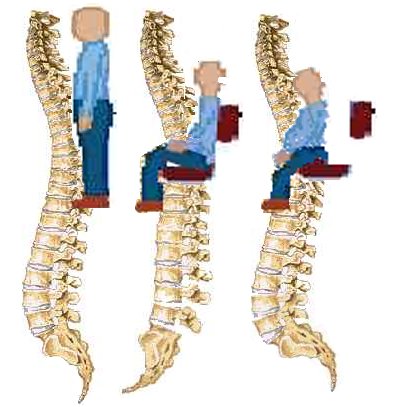|
|
|---|
(1) Dysfunctional Patterns of Movement and Muscle Recruitment:-
- Physiotherapist Shirley Sahrmann advocates to engage the Gluteus maximus at heal
strike for the majority of hip and buttock syndromes.
- Pain at the base of the spine stops Gluteus maximus engaging(3).
- Pain at the base of the spine stops the multifidis spinal muscles & transverse abdominal muscles engaging(3).
- Twisted ankle stops the Gluteus engaging(4).
- Pain at the base of the spine causes the psoas muscle to shorten and weaken(1,2,3,).
- 80% of Western people will suffer from debilitating backpain some time in their lives(5).
- Western style walking (comfortable shoes & flat ground) fails to trigger
muscles that stabilize hip joints & lower back.
Check this yourself by doing the author's
"bare foot walking test"(5).
Solution:-
- We need to train our whole minds and bodies in sound posture-movement and muscle
recruitment. This is not the same as orthodox stretch & strengthen programs!
The Back Maintenance Manual
, with exercises and lessons inspired by
Joseph Pilates, FM Alexander and
Shirley Sahrmann is designed to help with pain at the base of the spine!
Pain at the Base of the Spine, Causes and Solutions © Bruce Thomson, EasyVigour Project
|
(2) Disc Lesions at the Base of the Chair Sitting Spine:-
90% or more of all herniated lumbar discs are located immediately above or below
the lowest lumbar vertebra(6). Also, it is rare that a chair actually fits the person sitting in it.
These two facts are related. Thus, for:-
- A tall person with long legs, the base of the spine is strongly flexed (middle diagram, ref.6).
- A short person with a large abdomen, the base of the spine is strongly extended
(right hand diagram, ref. 9).
|
Diagram:
Chair sitting strongly flexes or extends the base of the spine , &
it does this when the supporting muscles (gluteals, multifidis
psoas, abdominals) & thoraco-lumbo-sacral fascia are all relaxed.
|

|
Solution:-
If you have pain at the base of the
spine when sitting, get up and walk at regular intervals!
The Back Maintenance Manual
will give you the competence in posture-movement, &
muscle tension awareness to minimize backpain when sitting.
|
|
(3) Triggerpoints
- Triggerpoints are nearly always involved in muscle dysfunction(7). They are a frequently overlooked cause of
lower backpain.
Clair Davies
is the undisputed world authority on triggerpoint self massage, please refer to the
review of his book:-
Triggerpoint Therapy Workbook...
Reference:-
- Dangaria TR; Naesh O: Changes in cross-sectional area of psoas major muscle in unilateral sciatica caused by disc herniation.
www.spinalinjuryfoundation.org/101_new/
sizeof.htm
-
Warren Hammer: The Psoas Syndrome www.chiroweb.com/archives/10/03/25.html
-
By Rodney Corn: Putting the Maximus back in your gluteus
www.nasm.org/education/newsletter/
case_studies/gluteus_maximus_pt1.asp
-
Bullock-Saxton JE, Janda V, Bullock MI.
Int J Sports Med. 1994 Aug;15(6):330-4. The influence of ankle sprain injury on muscle activation during hip extension.
-
Bruce Thomson:
Engage gluteus maximus
-
Loewenstein H, Patterson J& Shuke J: Comparison Of Lumbar Curves, When Sitting On The Nada-Chair,
Sitting On A Conventional Chair And Standing.
http://www.nadachair.com/Comparison%20of%20Lumbar%20Curves.pdf
- Clair Davies:
The Triggerpoint Therapy Workbook...
Publ. New Harbinger Publications 2001
- Bruce Thomson: Consequences of Office Chair Sitting.
- Shirley A Sahrman: "Movement Impairment Syndromes" Publ. Mosby, 2002 ISBN 0-8016-7205-8
|